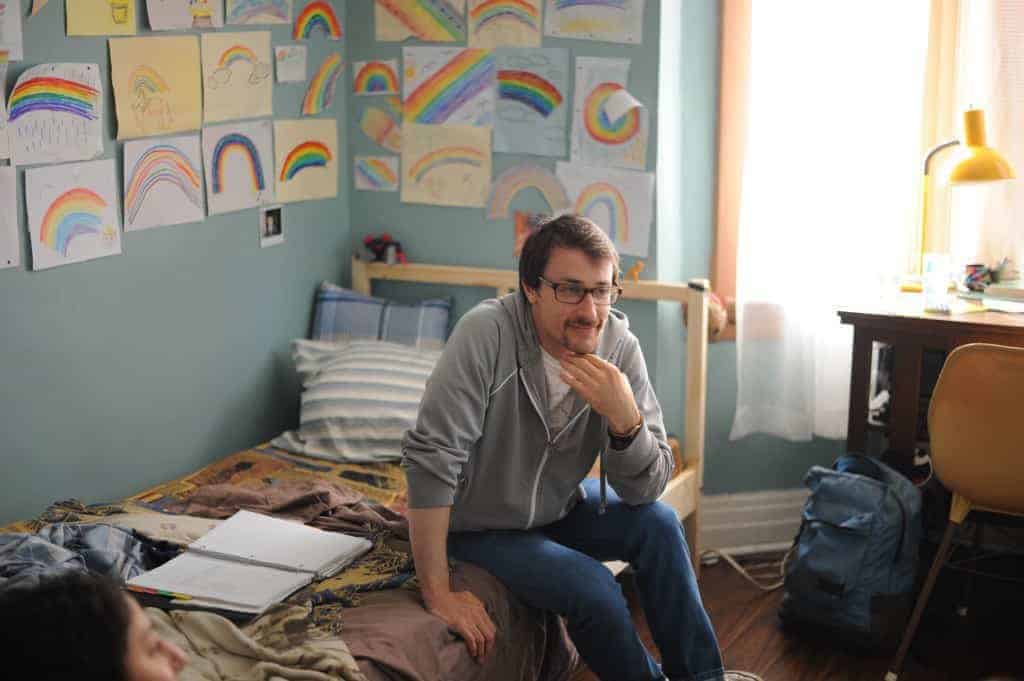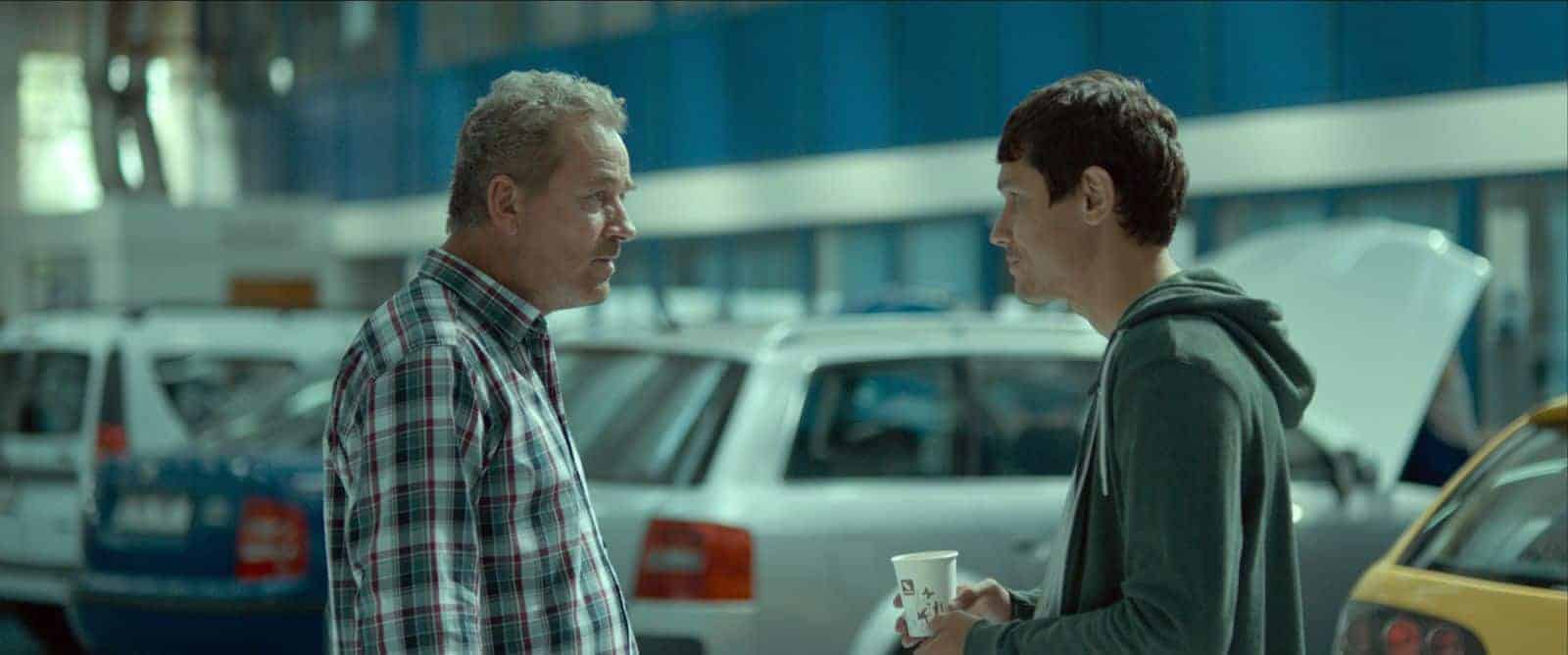
With his first feature, The Rainbow Kid, Canadian filmmaker Kire Paputts has made a landmark film. The film stars a character with Down Syndrome, Eugene (Dylan Harman), a naive boy whose mother can’t pay the rent. In an effort to prevent their eviction, he sets out on a journey to find the pot of gold at the end of the rainbow and solve their problems. Along the way, he meets an eccentric cast of characters, most of whom take advantage of him in some way, even as they may be offering him hospitality.
Eugene is never defined by his disability; it’s merely a limitation to cope with. His quest would be a challenge full of setbacks for any character, regardless of disability. But Eugene faces additional, different challenges because he has Down Syndrome. Paputts doesn’t shy away from subtly addressing the difficulties and limitations of living with Down Syndrome. It’s accurate and specific without making those limitations the focus of the film. The result is a touching, thoughtful film, and proof that actors with special needs can and should be carrying more films.
In anticipation of the film’s world premiere at the Toronto International Film Festival this weekend, I sat down with writer-director Kire Paputts to discuss the genesis of the film, working with his lead actor, and how he approached the aesthetic of the film.
Seventh Row (7R): What got you interested in making a film that has at the centre of it a character with Down Syndrome?
Kire Paputts: It was just a weird idea I got. “Oh, it would be kind of interesting to have this guy with a disability wandering off to find a pot of gold at the end of the rainbow.” The more I thought about it, I couldn’t shake it. It kept coming back to me. So I started to do more research and just expand upon it.
As I was doing research, trying to see other films that had people with special needs in them, it was really hard to come by anything. I had to really dig. There’s probably about a handful of films tops that I was able to get my hands on that actually had an actor with special needs in a starring role. At that point, it got a little more political for me. Well, why is that? Why can I only find about 4 films? So that kind of fueled things further for me, really wanting to get it done, and do something different. Also, giving a voice to a bunch of actors who don’t really get the opportunity.
7R: What kind of research did you do for the film?
Kire Paputts: When I was writing the script, I started volunteering with a group in Toronto called DramaWay. They offer creative classes to people with special needs — singing, acting, that kind of thing — just to get in that world a bit. I really wanted to make sure that when I told the story, I brought some authenticity to it and wasn’t just relying on stereotypes that are out there. I fell in love with that, and I’m still volunteering with them today. It’s been five years. When the film winds down, I’m still going to go back and keep working. A lot of things that happen in the film have been inspired by things I’ve witnessed or taken part of in the class.
7R: How did you find the actors for the film?
Kire Paputts: Dylan is actually the only member of ACTRA, which is kind of like our union for actors in Canada, with Down Syndrome in at least Toronto, if not all of Canada, at least in his age range. When I was doing the short, I went to ACTRA like, “Look, you guys don’t have anybody on your roster. I want to go union but you don’t have anybody for me.” So they allowed me to have an open casting call for basically anyone in Ontario who wanted to come out and try out for the film.

The actress Krystal Nausbaum who plays his love interest Anna, because of our film she’s in the union now. Basically, they’re the only two around. Whenever shows come to Toronto, and they’re looking for someone with Down Syndrome, they usually get pulled in for the same part. They audition for the same role. Then whoever they like more, they’ll change the role for a female or male, depending on who they like better.
In some ways, it’s good for them, because there’s very little competition. But in other ways, there still isn’t really that much work. He’s been acting since he’s five, but only in the last few years has he gotten some bigger roles. I’m hoping this film will at least get him something else, that people will see it and be inspired to write a script for him, even if it’s a supporting role.
7R: The film deals with a lot of different angles about what it is to live with Down Syndrome. Eugene has a rich inner life and a lot of agency. You also deal with a lot of the darker sides of living with Down Syndrome. He can’t just go off on an adventure like anybody else without having difficulties, and both he and Anna have parents who are really problematic.
Kire Paputts: I think what’s out there in the mainstream, when you’re looking at actors with special needs, the content is usually handled more with kid gloves. It’s told with a sympathetic eye. My goal was you really can’t escape the disability — he has a disability and it is what it is — but I didn’t want it to be the focus of the film. I wanted to created a story that anybody would struggle with, even if he didn’t have Down Syndrome.
This is an interesting character who has a lot of adversity but who happens to have a disability on top of that. Looking at that with Dylan and the character of Eugene, I wanted to push some boundaries and break down some barriers in regards to what people expect when they hear there’s a movie out there with a guy with Down Syndrome. They probably have this preconceived notion of what that is, and I wanted to take that expectation and flip it on its head. I haven’t shied away from the darker content, and I think it has a lot of heart, as well.
7R: What was it like working with Dylan, who also starred in your short film Rainbow Connection, which you made first?
Kire Paputts: I’ve worked with Dylan for five years on-and-off. We’ve really grown a special bond. We’re almost like a married
couple in some ways, in the good and bad ways. We would fight every day on set for the feature. But that was because I really wanted to push Dylan. I really wanted to get the best out of him. I didn’t want to treat him any differently than any other actor. That was really important to me, to treat him how I’d treat any actor.
I don’t think he was used to that. I think when he does other shows or films, people are a little more delicate around him, and they kind of buy into the disability. Sometimes, I’d forget that he even has a disability. Now, when I watch the film, it’s like, “Oh yeah, he has Downs.” Even on set, a lot of the crew, they’d never worked with anyone with special needs before. They were pretty surprised about how me and him were interacting. After a while, they just saw him as any other actor, as well, which was kind of special.
7R: How did you develop the aesthetic for the film? The colours are beautiful and so are the landscapes.
Kire Paputts: A lot of that was my DoP [Director of Photography], Maya [Bankovic]. She’s amazing. I always wanted it to be a really colourful, bright film, especially after the first act, after he leaves his house. I wanted that to be a bit drab. But kind of like Wizard of Oz, all of a sudden you’re in Oz and everything is more interesting and vibrant and crazy.

I got some inspiration for the look from Paris, Texas. I just loved the look of it. I loved the landscapes. It’s set in a desert, a lot of it. I just really liked a lot of the compositions and the looks. I knew I always wanted to film again in the fall, because I wanted to have as much interesting colours as possible. So with that brought a lot of issues because we didn’t have crazy amounts of money, and a lot of it was exteriors. We had to pray that the weather wasn’t crazy. We couldn’t afford to have heated tents or anything like that.
7R: What was your approach as far as the perspective of the film? Were you thinking of trying to follow Dylan’s perspective?
Kire Paputts: The opening shot of the film is just [Dylan’s] eyes. I wanted to cue the audience right away that this was going to be a different perspective. Because with Down Syndrome, a lot of it is in the eyes. You can tell right away, “Oh, that guy has Downs,” because of the eyes. I wanted to cue the audience that this would be a different perspective that maybe they haven’t seen before, or haven’t seen much of.

A lot of stuff within the film, a lot of mistakes that Dylan made or improv that he would do, we left in, because I wanted to give the film more authenticity. Obviously, we had plot beats and certain things that had to happen. But sometimes, we’d be just like, “OK, this is the tone we’re going with for this scene. Let’s just have fun with it and see what happens.”
That really long take with him and Julian Richings, that punk rock character, again, there was kind of a script, but it was kind of like, let’s dive into this and see what you get. I wanted to do a long take in the film to have an opportunity to just let Dylan shine without having to work around him with editing techniques or anything, just this is what it is. This is Dylan.
7R: What were your criteria for thinking about how you wanted to shoot the film?
Kire Paputts: In the beginning, especially, there’s a lot of framing we did where the characters would be cut off or obstructed for a lot of the scene. I think that created a lot of the tone. The first act is pretty dark and bleak before he goes off.
I also wanted that framing to isolate the character of Eugene. Although he’s with someone else, with his mom or with the social worker, we’re still mostly focused on him. He’s still alone in the world we’re creating.
7R: Are you working on anything else now?
Kire Paputts: I’m working on a few things now. I optioned this book I’m trying to get made called The N-Body Problem. It’s by a Canadian author named Tony Burgess. He writes a lot of weird shit. He also did Pontypool. I guess that’s his big thing. But he also does a bunch of horror/sci-fi scripts for a bunch of kids in Collingwood, like horror/sci-fi genre films. The film is actually more sci-fi, which is a total departure from The Rainbow Kid. But it’s also going to cost me probably a few million to make so it’ll be a lot different, if I can get it made.
[youtube https://www.youtube.com/watch?v=ZRRWXMy_yEM]
“The Rainbow Kid” screens Sat., Sept. 12 at 7:15 p.m. in Scotiabank 14, Mon. Sept 14 at 9:30 p.m. in Scotiabank 8, and Sat. Sept. 19 at 10:30 a.m. in Scotiabank 14. For tickets and more information, visit the TIFF website here.

